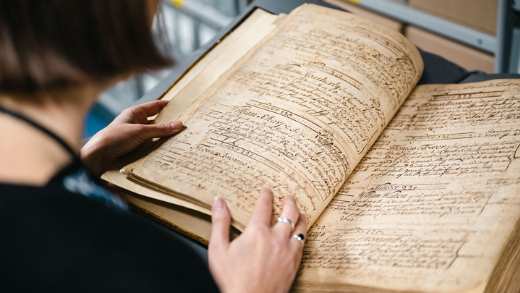Head over to the project's website at amicablecontributors.com, where you will find all the information you require to start contributing to the project. Detailed "how to" guides can be found on this page, below the FAQs section.
About the project
In 2021, we began an ambitious project to digitise our earliest policy registers. These belonged to the Hand in Hand Fire Office and date from 1696-1865. This represents over 59,000 pages worth of material, much of which hasn't seen the light of day for decades, if not centuries. It has been painstaking work to ensure the quality of each scan whilst taking the upmost care to protect the volumes in the process. There are approximately 550,000 policy entries recorded within the registers, each giving an insight into the lives of our earliest customers: from royalty, to cheesemongers, peruke (wig) makers, and gingerbread bakers. Having been transcribed automatically using a tool called Transkribus, we'd now like volunteers to help with the next step. Read on to find out more.
Get involved
Anyone can contribute to this project. We hope this will help put "flesh on the bones" of the individuals insured and, at the same time, provide an interesting snapshot of London at a particular moment in its history. Head over to amicablecontributors.com to get started, or see the sections below for more information.
Transcript for video Amicable Contributors: a crowdsourcing project
In this video, we're going to run through the basics of the project and how to get started.
The goal is to locate policies as pins on the map.
Map layers can be turned on and off, using the sidebar and opacity adjusted.
We found this layer to be the most useful, but you may need to refer to others at times.
On the right is the policy extract and, below this, the transcription.
It's possible to navigate the extract and to zoom in and out.
Use this button to reset the view, and this function is useful if you need to refer to the record above, or any others.
So let's locate this example.
The policy mentions the parish of Saint Ann, Black Fryers.
If we go to Parish search and type in St Ann, we can bring it up on the map.
The policy also mentions Meeting House Court and Water Lane, which is actually called Water Street on the map.
If we zoom in a bit, we can see Meeting House Court, or yard, and the policy mentions that the building in question is located on the north side around about here. I have placed the pin and I can now indicate a level of certainty.
This example is more or less exact.
Before moving on, we would also like users to check the accuracy of the transcription.
For example, Denrill needs to be corrected to Denzill. Once happy, use the "Validate" button to save changes and proceed.
Lastly, if you think you've made a mistake, "Reset" will undo all changes, and the "Cancel" button will discard the policy and give you a new one.
More information can be found on the help pages.
FAQs
How do I get started?
Are there any rules I must follow?
Please be as accurate as you can. When it comes to transcribing text, the golden rule is to write what you see. Instructions on how to get started can be found on the project website at amicablecontributors.com. More detailed guides can be found below. If you have any questions, please get in touch by email archive@aviva.com.
What if I'm unsure?
Do not worry if you are unsure about something. Use the Precision slider to indicate your level of certainty when placing pins on the map. If you're uncertain of a word in the transcription, it's best to leave it as it is. If you would prefer to try a different policy instead, use "Cancel" to dismiss the current record.
Why "Amicable Contributors"?
The Hand in Hand came to be known by this moniker because of its emblematic fire mark, which depicts two hands clasped together with a crown over them. Before this, it used variations on a theme of "Amicable Contributionship" to describe itself. Hence this small homage to our oldest ancestor.
How can I contact you?
If you have any questions about the project, or the Archive in general, please get in touch by email archive@aviva.com. More information about the Archive can be found here.
What if the policy is outside of London?
Areas not covered by the historical maps will still appear on the contemporary map base layer and can still be pinned. It may be harder to place individual properties accurately on the modern map. You can show how accurately you think you have placed the pin using the precision slider on the right above the policy extract.
What if I can't find a parish or street?
Although parish and street search provide a useful starting point, they are not comprehensive. It is possible to explore the map manually if you have a good idea where to start looking. If not, contemporary sites (e.g. Google Maps), or a general web search can be fruitful. Try searching for the street or parish in inverted commas [e.g. "St Dunstan's Hill"]. Including a date should improve relevant hits. If you would prefer to try a different policy instead, use "Cancel" to dismiss the current record.
What if there are multiple parishes or streets with the same name?
You are likely to come across many parishes or streets with the same, or similar, names. If it's not possible to narrow down the area using either parish or street search, see FAQ "What if I can't find a parish or street?".
Why is the map layer not showing?
If a map layer is slow to load, or not showing at all, try turning it "off" and "on" again using the sidebar, or zooming in/out.

